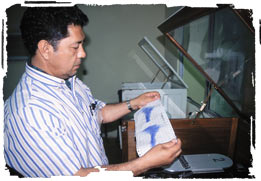CIMMYT E-News, vol 2 no. 9, September 2005
 CIMMYT’s wheat quality lab expands and upgrades to meet growing demand of wheat for diverse food uses.
CIMMYT’s wheat quality lab expands and upgrades to meet growing demand of wheat for diverse food uses.
If you live in the Middle East or North Africa, you probably eat couscous. Chapati, a type of flat bread, accompanies meals in India. Many have noodles with meals in China. As varied as these foods are, they all come from wheat but require different characteristics to be considered of “good quality”—so that the wheat will mill and bake well for the desired preparation. CIMMYT works to provide farmers worldwide with wheat that will be valued in their area and has recently expanded capacity to meet growing demand, which for developing countries is nearing 300 million tons of wheat per year.
“To make a wheat variety good for both the farmer and the eater, you need to consider yield, disease resistance, and quality,” says Roberto J. Peña, Head of Grain Quality at CIMMYT. Peña works with breeders at CIMMYT and national programs all over the world to test wheat quality. Traits such as yield and disease resistance are obvious at harvest, but examining quality traits such as starch content and elasticity require complex and time-consuming tests. These difficult tasks have become easier with a new laboratory and upgraded technologies.
To reduce the time it takes to screen for quality traits, CIMMYT has equipped a quality laboratory in Ciudad Obregon in northwestern Mexico, in addition to the lab at headquarters. Now thousands of wheat lines can be screened for quality immediately after being harvested in Obregon. CIMMYT wheat breeders can see the results before they plant the next round of wheat lines. Looking at desirable quality traits much earlier in the breeding process will save time, money, and plot size as it will be easier for breeders to plant only wheat with high quality and all of the other traits they are looking for.
Peña intends to make more use of techniques like near infrared spectroscopy (NIR) analysis and marker-assisted selection (MAS) to enhance the efficiency of quality testing. “By screening thousands of lines quite simply, we are able to have a clear vision of what wheat lines aren’t going to be useful—we’re implementing modern technologies for improving end-use and nutritional quality,” he says.
Near infrared spectroscopy can be used to evaluate grain texture, starch, protein, elasticity, and mineral content. By looking into these attributes it is possible to determine whether the environment or crop management influenced the quality—all of this without the effort of milling the wheat into flour, making dough, and finally baking it. When the tests are complete, the same grain can be planted and the breeder knows what to expect.
By using MAS data from CIMMYT’s molecular biology lab, Peña and his team can take a glimpse at a particular wheat line’s DNA to determine if particular genes are present or absent. They can also see what genes have a more relevant role in defining quality, as well as tell if wheat carries high or low levels of protein. For example, if wheat has high levels of protein, it will be more elastic. In the future, they hope to start testing for the presence of specific genes associated with milling efficiency and starch properties.
By continuing to select for quality, CIMMYT hopes to enable farmers to grow wheat for quality food, whether it be couscous, chapati, or sliced bread.
For further information, contact Roberto J. Peña (j.pena@cgiar.org).
 Capacity development
Capacity development